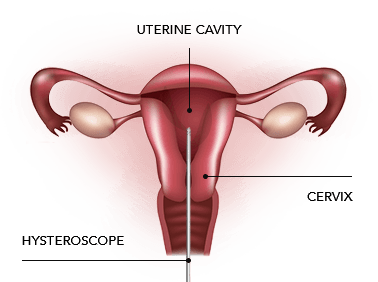Diagnostic Hysteroscopy
What is a Hystoroscopy?

A hysteroscopy is a diagnostic procedure used to examine the inside of a woman’s uterus. It involves inserting a thin, lighted scope through the vagina and cervix into the uterus. This allows the doctor to visualize the inside of the uterus and identify any abnormalities, such as polyps, fibroids, or growths. There are two types of hysteroscopies: diagnostic and operative. A diagnostic hysteroscopy is used to examine the uterus and gather information, while an operative hysteroscopy involves repairing or removing any abnormalities identified during the diagnostic procedure.The procedure is typically performed as an outpatient procedure and does not require an overnight hospital stay. It is usually done under local or general anesthesia, depending on the patient’s preference and the complexity of the procedure. After a hysteroscopy, most women can expect to have some mild cramping and spotting. It’s important to follow the postoperative instructions provided by your doctor and to make an appointment for a follow-up exam if needed.
- WHEN IS HYSTEROSCOPY SUITABLE? In case of abnormal uterine bleeding Upon investigation of an abnormal ultrasound finding For problems with painful menstruation In case of infertility due to uterine factors In case of infertility (inability to deliver a child) In the localization, extraction and reposition of the intrauterine device When checking after procedure on the uterus When removing residues after childbirth or abortion.
- HOW IS HYSTEROSCOPY PERFORMED?Think of the procedure as a routine gynaecological examination. At the beginning, disinfection is performed and the doctor introduces gynecological mirrors.The hysteroscope is inserted through your vagina and cervix into the uterus.The sterile liquid solution is then inserted into the uterus, through the hysteroscope, to expand it and to clear away any blood or mucus.Hysteroscope allows your doctor to see your uterus and the openings of the fallopian tubes into the uterine cavity.Finally, if surgery needs to be performed, small instruments are inserted into the uterus through the hysteroscope.
- HYSTEROSCOPY PROCEDURE: Hysteroscopy is a short gynaecological procedure in which a thin camera is gently inserted through the vagina and cervix into the uterine cavity. It is recommended to perform the procedure when the endometrium is the lowest, optimally within 10 days after your menstruation. Optimal timing can be achieved with single-phase hormonal contraception without omission or gestagen preparation.According to the range of performance and difficulty, we distinguish between operative and diagnostic hysteroscopy..
- DIAGNOSTIC HYSTEROSCOPY Diagnostic hysteroscopy is used to diagnose problems of the uterus or to confirm results of other tests (polyps, deformities, developmental defects of the uterus, septum, etc.)..
